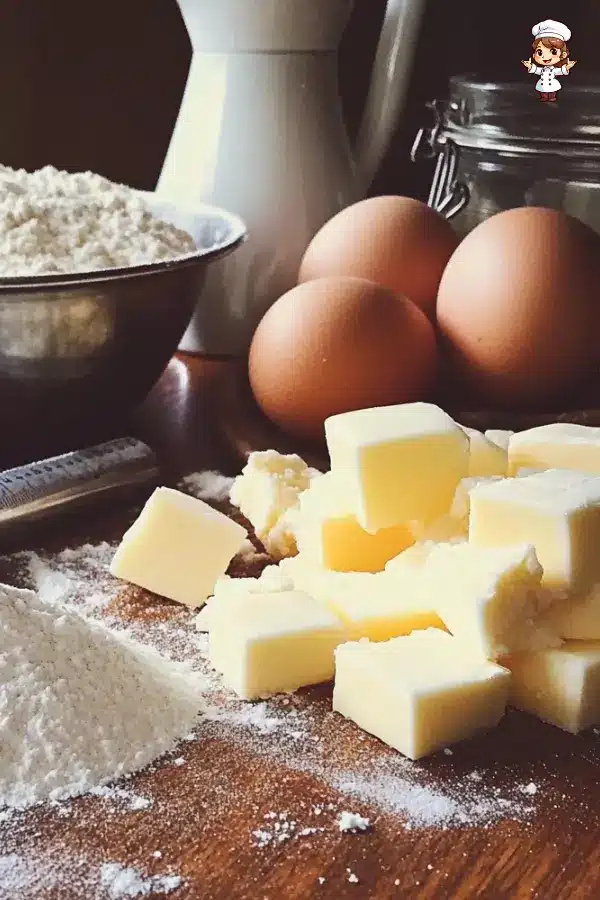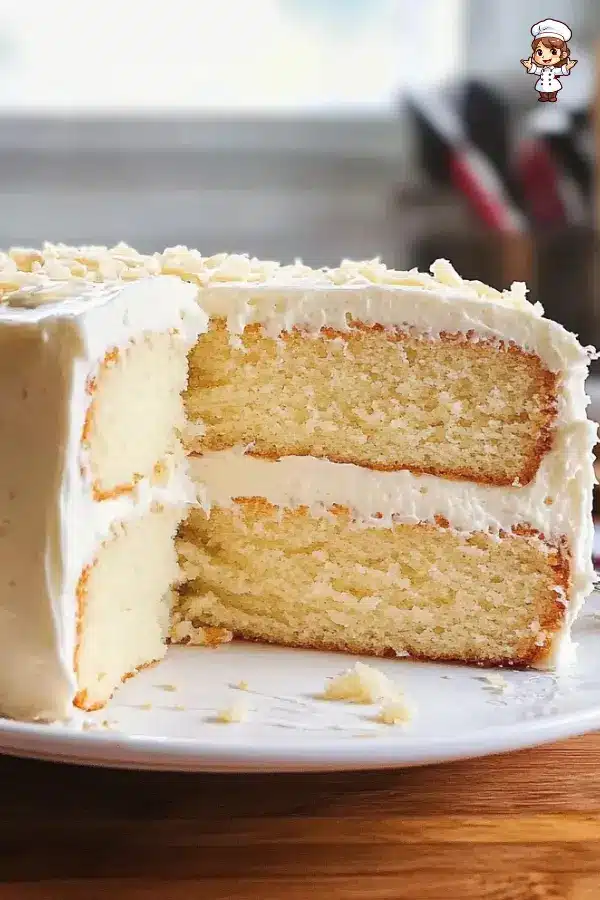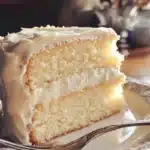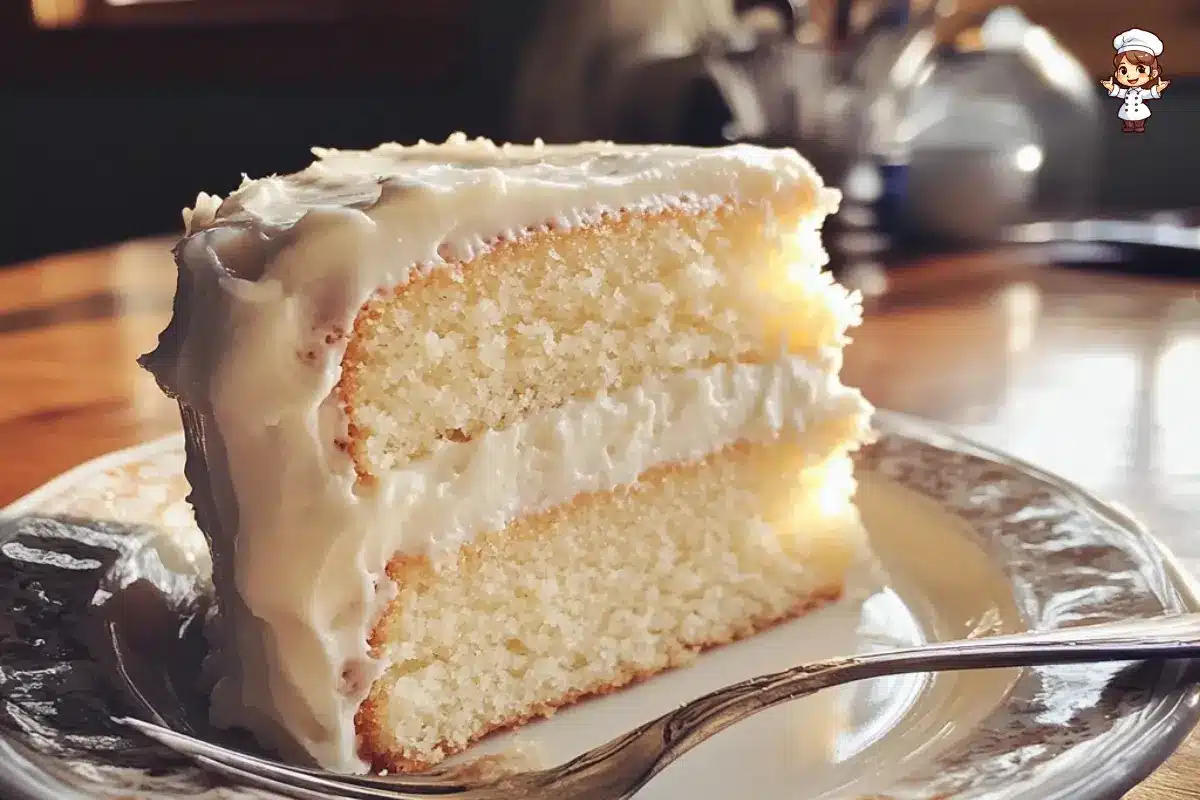There’s just something timeless about a vanilla cake. It’s simple, elegant, and always a crowd-pleaser — whether you’re celebrating a birthday, hosting a family dinner, or baking just because you feel like it. But here’s the thing: not all vanilla cakes are created equal.
This guide is your one-stop shop for crafting the best vanilla cake recipe from scratch — the kind that’s buttery, soft, and just the right amount of sweet. We’ll walk you through each step, from picking the perfect ingredients to decorating like a pro. You’ll also learn how to avoid everyday baking flops, store your cake the right way, and tweak the recipe for cupcakes, bundts, or gluten-free options.
By the time you’re done, you won’t just have a recipe — you’ll have a go-to classic that’ll wow your people every single time.
Let’s dive in!
Ingredients Matter – Choosing the Best for Your Vanilla Cake

Flour Power: Cake Flour vs. All-Purpose Flour
Let’s be honest—flour isn’t just flour. Choosing the right type makes or breaks your vanilla cake recipe. While many reach for all-purpose flour (and yes, it works), cake flour is the secret weapon. Why? It’s milled finer and has less protein, which means a softer, lighter crumb. That’s precisely what you want in a fluffy vanilla cake.
Still, if all-purpose is all you’ve got, don’t worry. You can use it—know the texture might lean a little denser. For best results, sift it well and don’t overmix. Seriously, less is more here.
Eggs, Butter, and Buttermilk – The Moist Crumb Trifecta
You’ve probably seen a ton of vanilla cake recipes calling for room-temperature ingredients. And yes, it’s not just a fancy tip — it’s essential. Eggs, unsalted butter, and buttermilk all play a role in creating that tender, melt-in-your-mouth texture.
- Eggs bring structure and richness. Extra egg whites add airiness without the heaviness of yolks.
- Butter? It’s what gives that buttery vanilla flavour everyone loves.
- And buttermilk? That’s the game-changer. It reacts with baking soda to create a super moist, soft crumb.
If you don’t have buttermilk, no worries! Stir a tablespoon of vinegar or lemon juice into regular milk and let it sit for 5 minutes—boom—instant substitute.
The Role of Vanilla: Extract, Paste, or Bean?
Here’s where your cake gets its soul. Vanilla isn’t just a flavour; it’s the essence of this recipe. Pure vanilla extract is the gold standard. It’s rich, warm, and aromatic. For an extra flavour kick, try vanilla bean paste or real beans scraped straight from the pod.
Skip the imitation stuff—it’s cheap for a reason. Use the best vanilla you can find, and your vanilla cake will thank you.
Step-by-Step Vanilla Cake Recipe with Pro Tips

Prep Like a Pro: Oven Temp, Pans, and Parchment Lining
Before you even think about mixing, set yourself up for success. Preheat your oven to 350°F (or 175°C) and give it a full 20 minutes to get hot. A consistent temperature ensures your cake rises evenly.
Next, grease your cake pans. Don’t just spray and pray—grease the sides with butter, then line the bottom with parchment paper. This guarantees your layers pop right out without breaking. Trust me, there’s nothing worse than a stuck cake when you’re halfway to dessert glory.
Creaming Butter and Sugar: Why It Matters
This step is where the magic begins. Creaming means beating butter and sugar together until they’re light and fluffy—about 3 minutes on medium-high. It traps air, which helps your vanilla cake recipe rise.
Add eggs one at a time. Then, toss in your vanilla extract. Mixing too fast? You’ll knock out all that lovely air. So take it slow and easy.
Incorporating Wet and Dry Ingredients Without Overmixing
Now, it’s time to blend the dry and wet parts. Start by whisking together your flour, baking powder, baking soda, and salt. Alternate adding dry ingredients and buttermilk to the creamed mixture.
Here’s the trick: don’t dump it all in at once. Add the dry in three parts and the buttermilk in two. Stir just until combined. Overmixing leads to a dense cake—and nobody wants that.
Baking Time and Signs of Doneness
Divide your batter evenly into the pans. Please give them a gentle tap on the counter to release any giant air bubbles. Then, slide them into the centre of your oven.
Bake for 25 to 30 minutes or until a toothpick comes out clean. The tops should be golden, slightly springy, and smell like heaven.
Cooling and Leveling: How to Prep Your Cake for Frosting
Once baked, let your cakes cool in the pans for 10–15 minutes. Then, gently turn them out onto a wire rack. Always cool them completely before frosting—or your buttercream will melt right off.
Want perfect layers? Grab a serrated knife and level the domes off the top. Not only will your cake look pro, but it’ll also stack like a dream.
How to Make the Perfect Vanilla Buttercream
The Butter-to-Sugar Ratio That Works Every Time
Let’s talk frosting. A good vanilla cake recipe is only as good as its buttercream. You want something silky, rich, and easy to spread — or pipe if you’re going fancy. The golden ratio? About 1 part butter to 2.5 parts powdered sugar.
Start with room-temperature unsalted butter. It should be soft but not melting. Beat it for a couple of minutes until it’s pale and fluffy. Then, slowly add sifted powdered sugar in batches. Doing this gradually avoids that classic sugar explosion (and trust me, cleaning up powdered sugar clouds isn’t fun).
Want a richer texture? Use a bit of heavy cream or whole milk — just a tablespoon at a time — until it hits that perfect spreadable consistency.
Flavoring and Adjusting Consistency
Of course, we can’t skip the vanilla. Use pure extract for the most profound flavour. A teaspoon or two goes a long way. If you really want to elevate it, a dash of vanilla bean paste brings those specks of magic that scream bakery-style frosting.
Now, here’s the beauty of this frosting — it’s totally adjustable. Want it thicker? Add more sugar. Too sweet? A pinch of salt balances it out.
This buttercream pairs like a dream with your cake’s fluffy texture. Whether you’re slathering it between layers or swirling it on top with a piping tip, it takes your vanilla cake recipe from good to unforgettable.
For more sweet inspiration, check out our almond nut cake recipe. 🍰
Decorating Ideas for Your Vanilla Cake
Elegant: Fresh Flowers, Berries, or Edible Gold
Sometimes, less is more. If you’re leaning into a clean, elegant style, decorate your vanilla cake with a minimalist touch. Fresh berries — think raspberries, blueberries, or sliced strawberries — instantly dress up the top. Want something extra special? Edible flowers or a sprinkle of edible gold leaf adds a significant wow factor.
Try spreading your vanilla buttercream with swooping motions using an offset spatula, then finish with a simple garnish. It looks like you bought it from a boutique bakery — but nope, it’s all you.
Fun: Sprinkles, Confetti Layers, or Ganache Drips
Now, if you’re baking for a party or celebration, go bold! Sprinkles are a no-fail hit, especially for birthdays. Mix them into the batter for a confetti effect, or sprinkle them over frosting.
Want to up the ante? Try a chocolate ganache drip — simply warm heavy cream and pour it over chopped chocolate, then drip along the edges of the cake. It looks fancy but is surprisingly easy.
This vanilla cake recipe is a blank canvas, so get creative! Use colourful frosting, pipe rosettes, or even add a layer of jam in between.
No matter how you decorate it, one thing’s for sure — your cake will taste as amazing as it looks.
Variations on the Vanilla Cake Recipe
Vanilla Cupcakes Using the Same Batter
One of the best things about this vanilla cake recipe? It’s incredibly flexible. You can use the same batter to make delicious vanilla cupcakes. Just line your cupcake tin, fill each about 2/3 full, and bake at 350°F (175°C) for 18–22 minutes.
This shortcut saves time and gives you mini versions of the cake everyone loves. Whether you’re baking for a kids’ party, office gathering, or just portion control (we see you!), these cupcakes are moist, fluffy, and easy to decorate.
Top them with a swirl of vanilla buttercream, a cherry, or a handful of sprinkles — and you’ve got bakery-worthy treats without the price tag.
Turning It into a Sheet Cake or Bundt Cake
Need something simple and crowd-friendly? Pour your vanilla cake batter into a 9×13-inch pan for a classic sheet cake. It’s great for casual get-togethers or potlucks. You get the same lovely flavour without the need to layer or level.
Want something more showy? Use a Bundt pan. Just remember to grease every crevice well and extend the bake time to about 50–60 minutes. The result is a rich, golden ring of cake that looks fancy — no decorating needed.
This vanilla cake recipe is all about options so that you can bake it your way every time.
Common Mistakes and How to Avoid Them
Flat Cakes? It Might Be Your Baking Powder
Have you ever baked a cake that came out dense or flat? You’re not alone. One of the biggest culprits in a failed vanilla cake recipe is old or inactive baking powder. Always check the expiration date and store it in a cool, dry place. A quick tip? Mix a little in hot water — if it bubbles, it’s good to go!
Another issue is oven temperature. If your oven runs too hot or too cold, your cake may rise unevenly or sink in the middle. Use an oven thermometer to be sure you’re baking at the correct heat.
Dry Texture? Could Be Overmixing or Overbaking
No one wants a dry cake. If your vanilla cake is turning out crumbly or challenging, you might be overmixing the batter. Once the flour goes in, mix just until combined. Too much stirring develops the gluten, which leads to a dense bite.
Also, keep an eye on your bake time. Ovens vary, so start checking a few minutes early. A clean toothpick doesn’t mean bone-dry — you want a few moist crumbs sticking to it.
With these simple fixes, your vanilla cake recipe will be soft, tall, and just right — every time.
Storing, Freezing & Making Ahead
How to Store Frosted vs. Unfrosted Cake
Once your vanilla cake recipe is baked and frosted, the next question is — how do you store it? If it’s already frosted, cover it loosely with plastic wrap or place it in a cake carrier. Then, keep it at room temperature for up to 2 days. If your kitchen runs warm, store it in the fridge and let it come to room temp before serving.
For unfrosted layers, wrap them tightly in plastic wrap and keep them in an airtight container. They’ll stay fresh for about 3–4 days this way.
Freezing Layers Without Losing Moisture
Want to get ahead? You totally can. Freeze the cake layers after they cool completely. Wrap each one tightly in plastic wrap, then foil. Pop them into a freezer-safe bag and store them for up to 3 months.
When you’re ready, thaw the layers at room temperature. They’ll still be just as moist and perfect for assembling your vanilla cake recipe without the last-minute rush.
FAQs About Vanilla Cake Recipe
What Makes Vanilla Cake Moist and Fluffy?
The magic combo is room temperature ingredients, the right flour (like cake flour), and not overmixing. Add in buttermilk, and you’ve got a cake that’s soft, tender, and perfectly fluffy. Using both baking soda and baking powder also helps it rise without being dense.
Can I Use Oil Instead of Butter in a Vanilla Cake Recipe?
Yes, you can — but it will change the texture. Oil makes cakes moister, while butter gives that rich flavour. If you substitute, use a neutral oil like canola and adjust the amount slightly. Just know that your vanilla cake recipe may feel softer but less buttery.
Why Does My Vanilla Cake Sink in the Middle?
This often comes down to underbaking or opening the oven door too early. Be sure to bake until a toothpick comes out clean. Also, avoid sudden temperature drops, which can make the centre collapse.
How Do I Make Vanilla Cake Taste Better?
Want to level it up? Try adding a splash of almond extract, a bit of vanilla bean paste, or layering in some jam. Minor tweaks can take your vanilla cake recipe from great to unforgettable.
Print
Vanilla Cake Recipe
- Total Time: 50 minutes
- Yield: 12 slices 1x
- Diet: Vegetarian
Description
This vanilla cake recipe is your go-to for a fluffy, moist, and buttery cake. Made from scratch with simple ingredients like cake flour, butter, eggs, and buttermilk, it’s perfect for birthdays, weddings, or just because. The cake is soft with a light crumb, and when paired with a rich vanilla buttercream, it’s truly irresistible. Whether you’re making a multi-layered cake or cupcakes, this versatile recipe will never disappoint.
Ingredients
- 2 cups all-purpose flour (or cake flour)
- 2 ½ tsp baking powder
- ¼ tsp kosher salt
- 4 large eggs, at room temperature
- 1 ½ cups caster sugar (or granulated sugar)
- ½ cup (115g) unsalted butter, cubed
- 1 cup whole milk
- 3 tsp pure vanilla extract
- 3 tsp vegetable or canola oil
- For Vanilla Buttercream:
- 2 sticks (225g) unsalted butter, softened
- 4 cups (500g) powdered sugar, sifted
- 3 tsp vanilla extract
- 2–4 tbsp milk (to desired consistency)
Instructions
- Preheat oven to 350°F (180°C) or 320°F (160°C fan). Grease and line two 8-inch cake pans with parchment paper.
- In a large bowl, whisk together the flour, baking powder, and salt. Set aside.
- Beat eggs on medium-high speed for 30 seconds, then gradually add sugar while beating. Continue mixing until the mixture triples in volume and becomes pale and airy (about 7 minutes).
- While eggs are whipping, heat milk and butter in a microwave-safe jug for 2 minutes, or until butter melts. Add vanilla and oil to the hot mixture.
- Gently fold one-third of the flour mixture into the egg mixture. Repeat twice more until just combined.
- Mix about 1½ cups of the egg mixture into the milk-butter mixture. Whisk until smooth and foamy.
- Slowly pour this back into the main egg batter while mixing on low speed. Stir until combined.
- Divide the batter between the pans. Tap each pan gently on the counter to release air bubbles.
- Bake for 30 minutes or until a toothpick comes out clean. Let cakes cool in pans for 15 minutes, then turn out onto racks.
- To make the buttercream, beat butter until light and fluffy. Gradually add powdered sugar, vanilla, and milk until desired texture is reached.
- Frost once cakes are completely cool. Level layers if needed for a neater finish.
Latest Amazon Finds
Notes
- For an extra-moist result, substitute half the milk with buttermilk.
- Want to make cupcakes? This easy vanilla cake recipe yields about 24 standard cupcakes. Bake for 18–20 minutes.
- Store frosted cake at room temperature for 2 days or refrigerate for up to 5 days.
- Freeze unfrosted cake layers by wrapping tightly in plastic wrap and storing in a zip-top bag for up to 3 months.
- Prep Time: 20 minutes
- Cook Time: 30 minutes
- Category: Dessert, Cake
- Method: Baking
- Cuisine: American
Nutrition
- Serving Size: 1 slice
- Calories: 410
- Sugar: 35g
- Sodium: 190mg
- Fat: 22g
- Saturated Fat: 13g
- Unsaturated Fat: 7g
- Trans Fat: 0.5g
- Carbohydrates: 50g
- Fiber: 1g
- Protein: 4g
- Cholesterol: 80mg
Keywords: vanilla cake recipe, fluffy vanilla cake, moist vanilla cake, easy vanilla cake recipe, vanilla buttercream cake, classic vanilla cake, birthday cake recipe



